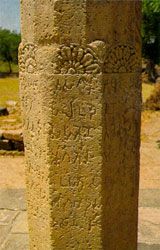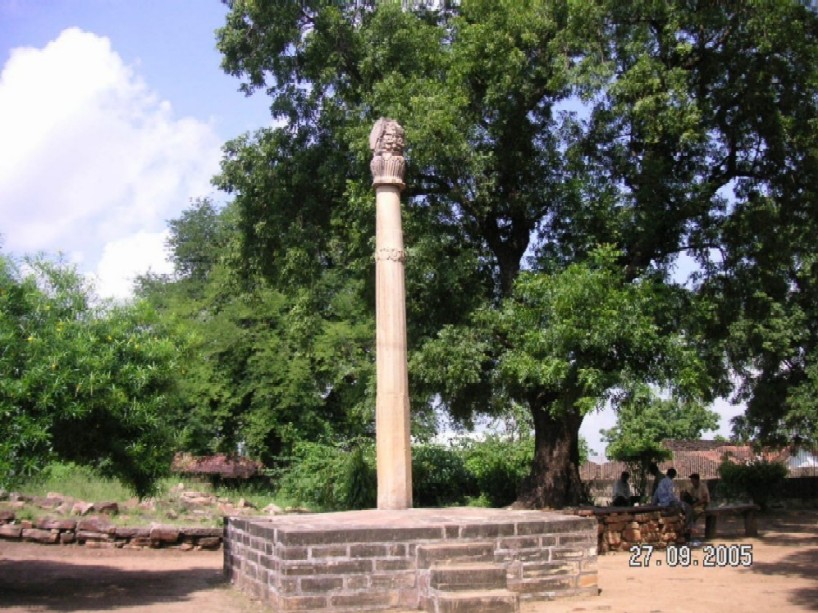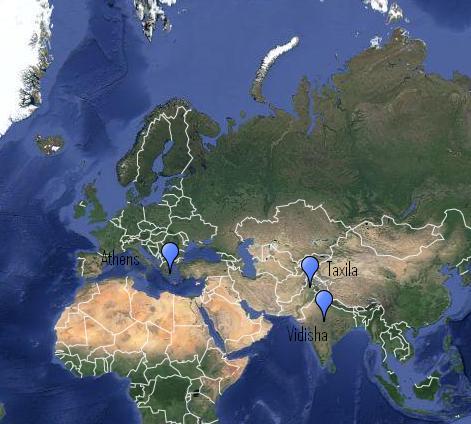Greeks in Ancient India? The Heliodorus Pillar November 7, 2014
Author: Beach Combing | in : Ancient , trackbackThe Heliodorus Pillar is one of those wrong place Euroasian antiques, which should make any self-respecting bizarrist choke up. It is a simple, still standing sandstone Hindu column, at Vidisha near Bhopal in India, known locally as the Khambh Baba. The column was placed there in about 110 BC so it is a good two thousand years old. There are lots of old columns in India, of course, and Hinduism is a religion with a long history, so nothing strange thus far. Nor is the design particularly remarkable: though there have been some mutterings about foreign influence. It is, too, sadly, lacking the giant eagle that once surmounted it. But enough of the pedestrian. What does stand out is the inscription in Brahmi.
This Garuda column of Vasudeva, the god of gods, was erected here by Heliodorus, a worshiper of Vishnu, the son of Dion, and an inhabitant of Taxila, who came as ambassador from the Great Yona King Antialkidas to King Kasiputra Bhagabhadra, the Savior, then reigning prosperously in the fourteenth year of his kingship. Three important precepts when practiced lead to heaven: self-restraint, charity, conscientiousness
[For anyone who might have better Brahmi than me]1) Devadevasa Va[sude]vasa Garudadhvajo ayam 2) karito i[a] Heliodorena bhaga- 3) vatena Diyasa putrena Takhasilakena 4) Yonadatena agatena maharajasa 5) Amtalikitasa upa[m]ta samkasam-rano 6) Kasiput[r]asa [Bh]agabhadrasa tratarasa 7) vasena [chatu]dasena rajena vadhamanasa

So why should we care? Well, the names are shocking. Heliodorus and Antialkidas are clearly and unmistakably Greek even in Brahmi. Second, were there any doubt ‘Yoni’ is the Brahmi word for (among other things) the Greeks. Can we can deduce anything else? Antialkidas seems to have been a Greek king ruling a satrapy in modern Pakistan, the most eastern of Alexander’s successor kingdoms, two hundred years after Alexander’s death: coins also survive from his reign. Just to give you a sense of distance, the Taxila mentioned on the column is in the Pakistani Punjab about twelve hundred kilometres to the north: Vidisha is, meanwhile, some 5500 kms from Athens. We can only speculate about the diplomatic mission that led to the making of this artifact, but we might wonder about Heliodorus, ‘a worshipper of Vishnu’: was this diplomatic nicety, or did Heliodorus actually venerate Vishnu along with Zeus (or was Vishnu, in fact, Zeus for Heliodorus)?
The inscription was hidden and protected for centuries by a red paste that pilgrims had plastered onto the sandstone. It was only, finally, in 1911, that a visiting British engineer named Lake scraped off some of this red paste and found the remarkable record below. Sam Miller records a beautiful later tradition in A Strange Kind of Paradise (2014). He met a woman there who told him that the column was a king, named Sikandar, who had been transformed into the sandstone. Sikandar is Alexander! SM was understandably excited but when he asked, his informant, about where she had learnt this fact, she told him, matter-of-factly, that a visiting scholar had passed on the information the year before. The dangers of tradition…
Of course, there is nothing here that obliges us to tear up text books. But there is something exciting, two hundred years after Alexander, about finding Greek speakers living in what is today Pakistan and visiting central India. Did they dream of the Mediterranean? Did they know the name ‘Rome’? Did they quote Homer in the foothills of Afghanistan? Other wrong place objects: drbeachcombing AT yahoo DOT com
29 Feb 2016: Bruce T. ‘Here’s what I’ve come up with. Heliodorus was an ambassador for Indo-Greek king Antialcidas Nikephoros who’s capital was in Taxila. It seems our Heliodorus was on both a religious and diplomatic mission to the Shunga King Kasiputra Bhagabhadra. He was visiting a temple in the Shunga Empire at Vidisha dedicated to the God Vasudeva who to the Indians is a avatar of Vishnu, but to the Indo-Greeks represented Zeus. Garuda the eagle like being that once topped the pillar is the mount of Vishnu. Zeus also had an eagle mount. For the Indo-Greeks it was easy to turn Vasudeva, who they called the “God of Gods” into Zeus. At Vidisha there was a large temple dedicated to Vasudeva, and this is where Heliodorus erected his pillar. (By the wording on the pillar and where it was placed, some Indian historians consider Heliodorus to be one of the first true Western converts to Hinduism) Heliodorus may have been killing two birds with one stone. There was an important Buddhist stupa at Sanchi roughly 8 kilometers away. Buddhism was an important religion in both the Indo-Greek and Greco-Bactrian states. As a diplomat you have to think he had to go there to press the flesh and bring back texts and relics to the Buddhists back home. Finally Vidisha was a major trade hub in this period, on the route from the west coast to the Gangetic plain. A perfect place for Greek speaker to be knocking around asking Greeks sailing from the Near East how things were in good old Antioch. There’s a lot to be found on Heliodorus if you look carefully. One last thing, on the speaking/writing of Greek on the subcontinent. There is some evidence it lasted as a diplomatic language until the push of the Hephthalites into Afghanistan and Pakistan in the Sixth Century. The Gupta Emperor, Chandragupta II had a habit of erecting pillars in regions he conquered or campaigned in. In the Gilgit region of Pakistan one still stands near Der. It has four sides each inscribed with a different language. One is in Brahmi, one is in Persian, one is in Aramaic, and one is in Greek. The pillar dates from roughly the turn of the Fifth Century. That tells us Greek was still being used in a form in the region at that time, but whether it was classical Greek or the Greek alphabet being adapted to another local language, a not uncommon occurrence in the history of that area, is beyond me. It may also have been a case of Greek being the Latin of the Hindu Kush and Bactria. Either way, Greek in the region seems to go the way of the Dodo after the Hephthalites overran the area. I’m as bad as you are. I found out about the Der pillar when researching the survival of the various peoples and beliefs of the region once known as Kafiristan. Want to read a little Kipling then head to the Masonic Hall, Beach?




